Treating Intellectual Property as Real Property: Pros and Cons
VerifiedAdded on 2023/01/05
|6
|2277
|83
AI Summary
This essay explores the extent to which intellectual property should be treated like real property, discussing the impact on creators and society. It examines the benefits and drawbacks of treating intellectual property as real property.
Contribute Materials
Your contribution can guide someone’s learning journey. Share your
documents today.

To what extent should intellectual
property be treated like real property
property be treated like real property
Secure Best Marks with AI Grader
Need help grading? Try our AI Grader for instant feedback on your assignments.
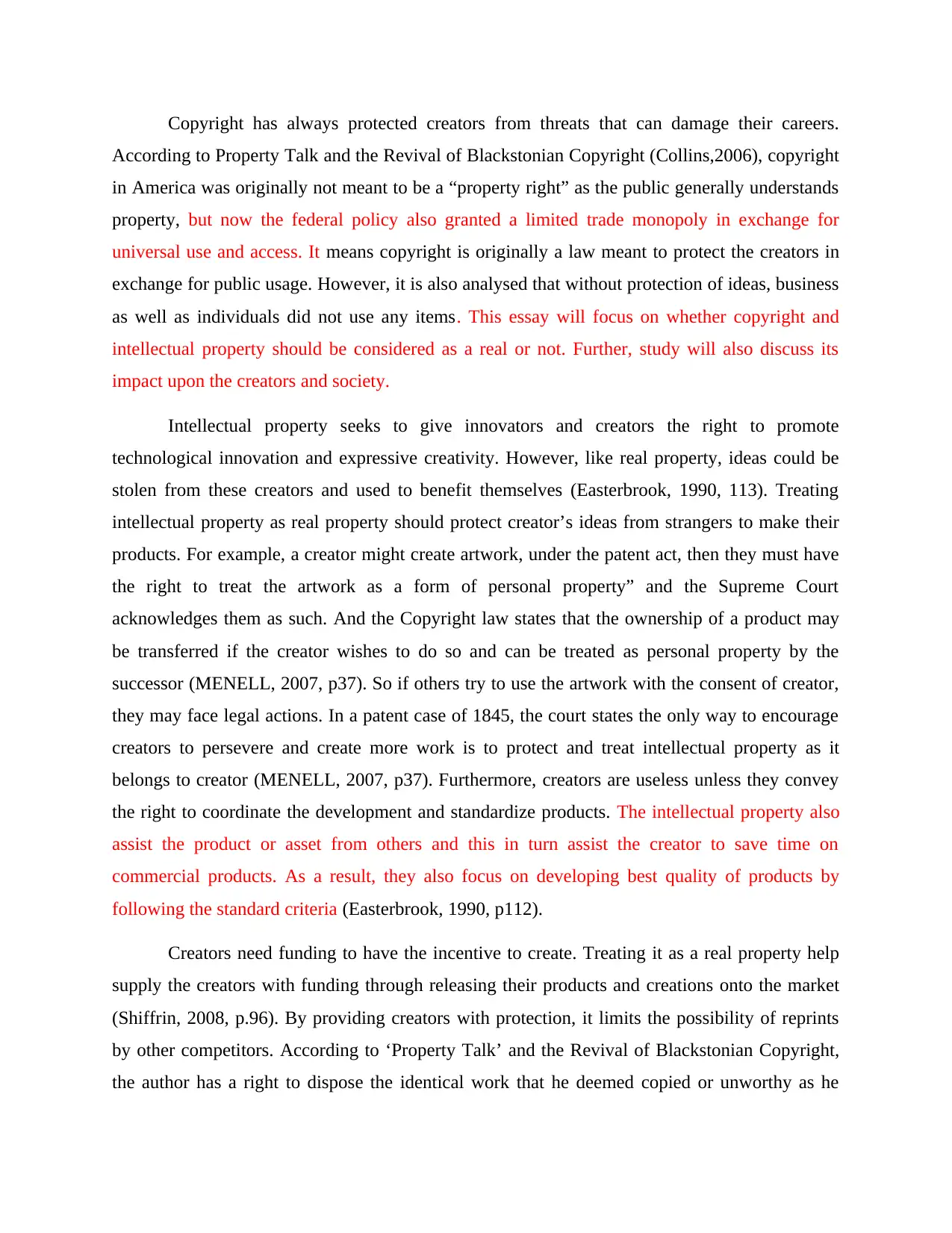
Copyright has always protected creators from threats that can damage their careers.
According to Property Talk and the Revival of Blackstonian Copyright (Collins,2006), copyright
in America was originally not meant to be a “property right” as the public generally understands
property, but now the federal policy also granted a limited trade monopoly in exchange for
universal use and access. It means copyright is originally a law meant to protect the creators in
exchange for public usage. However, it is also analysed that without protection of ideas, business
as well as individuals did not use any items. This essay will focus on whether copyright and
intellectual property should be considered as a real or not. Further, study will also discuss its
impact upon the creators and society.
Intellectual property seeks to give innovators and creators the right to promote
technological innovation and expressive creativity. However, like real property, ideas could be
stolen from these creators and used to benefit themselves (Easterbrook, 1990, 113). Treating
intellectual property as real property should protect creator’s ideas from strangers to make their
products. For example, a creator might create artwork, under the patent act, then they must have
the right to treat the artwork as a form of personal property” and the Supreme Court
acknowledges them as such. And the Copyright law states that the ownership of a product may
be transferred if the creator wishes to do so and can be treated as personal property by the
successor (MENELL, 2007, p37). So if others try to use the artwork with the consent of creator,
they may face legal actions. In a patent case of 1845, the court states the only way to encourage
creators to persevere and create more work is to protect and treat intellectual property as it
belongs to creator (MENELL, 2007, p37). Furthermore, creators are useless unless they convey
the right to coordinate the development and standardize products. The intellectual property also
assist the product or asset from others and this in turn assist the creator to save time on
commercial products. As a result, they also focus on developing best quality of products by
following the standard criteria (Easterbrook, 1990, p112).
Creators need funding to have the incentive to create. Treating it as a real property help
supply the creators with funding through releasing their products and creations onto the market
(Shiffrin, 2008, p.96). By providing creators with protection, it limits the possibility of reprints
by other competitors. According to ‘Property Talk’ and the Revival of Blackstonian Copyright,
the author has a right to dispose the identical work that he deemed copied or unworthy as he
According to Property Talk and the Revival of Blackstonian Copyright (Collins,2006), copyright
in America was originally not meant to be a “property right” as the public generally understands
property, but now the federal policy also granted a limited trade monopoly in exchange for
universal use and access. It means copyright is originally a law meant to protect the creators in
exchange for public usage. However, it is also analysed that without protection of ideas, business
as well as individuals did not use any items. This essay will focus on whether copyright and
intellectual property should be considered as a real or not. Further, study will also discuss its
impact upon the creators and society.
Intellectual property seeks to give innovators and creators the right to promote
technological innovation and expressive creativity. However, like real property, ideas could be
stolen from these creators and used to benefit themselves (Easterbrook, 1990, 113). Treating
intellectual property as real property should protect creator’s ideas from strangers to make their
products. For example, a creator might create artwork, under the patent act, then they must have
the right to treat the artwork as a form of personal property” and the Supreme Court
acknowledges them as such. And the Copyright law states that the ownership of a product may
be transferred if the creator wishes to do so and can be treated as personal property by the
successor (MENELL, 2007, p37). So if others try to use the artwork with the consent of creator,
they may face legal actions. In a patent case of 1845, the court states the only way to encourage
creators to persevere and create more work is to protect and treat intellectual property as it
belongs to creator (MENELL, 2007, p37). Furthermore, creators are useless unless they convey
the right to coordinate the development and standardize products. The intellectual property also
assist the product or asset from others and this in turn assist the creator to save time on
commercial products. As a result, they also focus on developing best quality of products by
following the standard criteria (Easterbrook, 1990, p112).
Creators need funding to have the incentive to create. Treating it as a real property help
supply the creators with funding through releasing their products and creations onto the market
(Shiffrin, 2008, p.96). By providing creators with protection, it limits the possibility of reprints
by other competitors. According to ‘Property Talk’ and the Revival of Blackstonian Copyright,
the author has a right to dispose the identical work that he deemed copied or unworthy as he
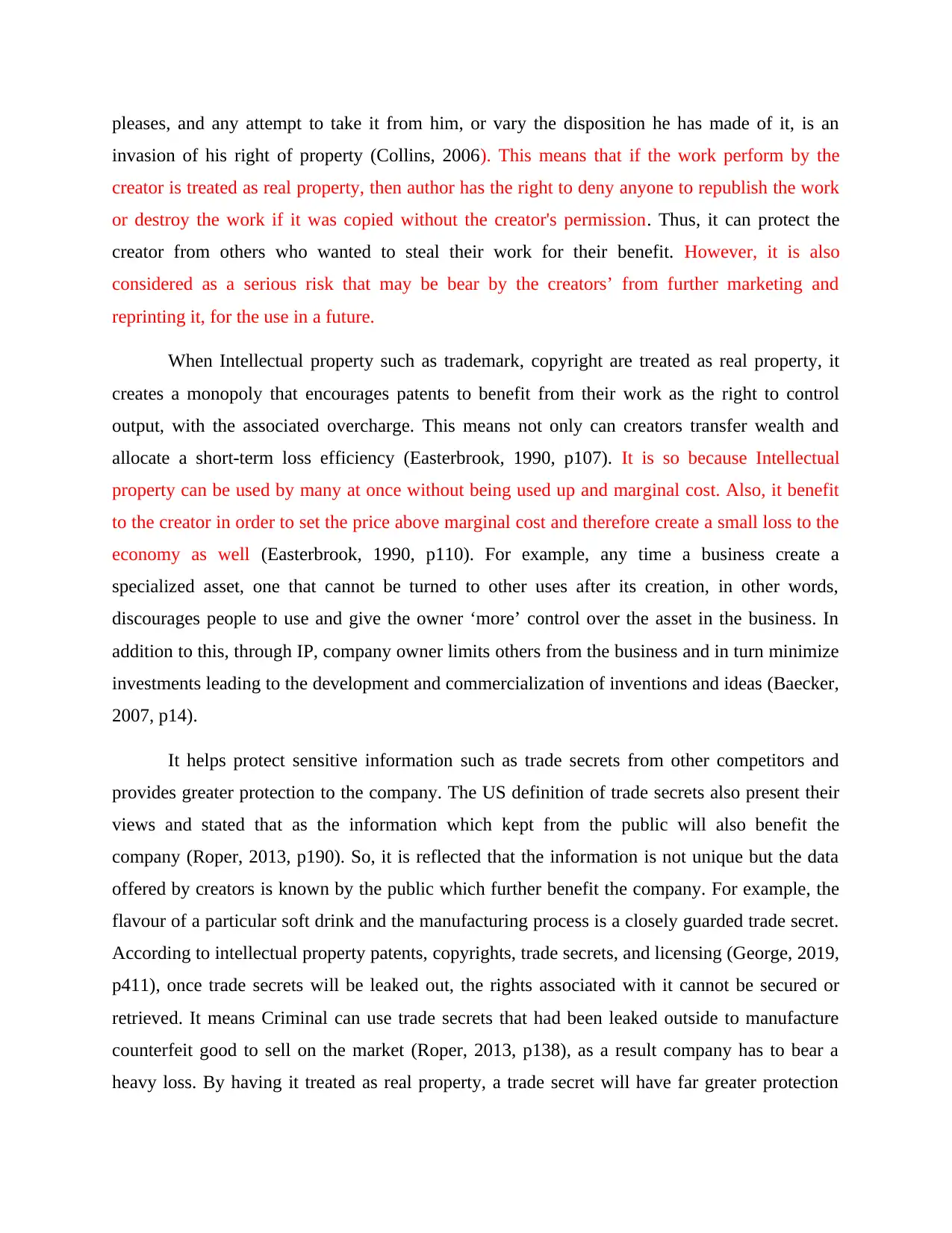
pleases, and any attempt to take it from him, or vary the disposition he has made of it, is an
invasion of his right of property (Collins, 2006). This means that if the work perform by the
creator is treated as real property, then author has the right to deny anyone to republish the work
or destroy the work if it was copied without the creator's permission. Thus, it can protect the
creator from others who wanted to steal their work for their benefit. However, it is also
considered as a serious risk that may be bear by the creators’ from further marketing and
reprinting it, for the use in a future.
When Intellectual property such as trademark, copyright are treated as real property, it
creates a monopoly that encourages patents to benefit from their work as the right to control
output, with the associated overcharge. This means not only can creators transfer wealth and
allocate a short-term loss efficiency (Easterbrook, 1990, p107). It is so because Intellectual
property can be used by many at once without being used up and marginal cost. Also, it benefit
to the creator in order to set the price above marginal cost and therefore create a small loss to the
economy as well (Easterbrook, 1990, p110). For example, any time a business create a
specialized asset, one that cannot be turned to other uses after its creation, in other words,
discourages people to use and give the owner ‘more’ control over the asset in the business. In
addition to this, through IP, company owner limits others from the business and in turn minimize
investments leading to the development and commercialization of inventions and ideas (Baecker,
2007, p14).
It helps protect sensitive information such as trade secrets from other competitors and
provides greater protection to the company. The US definition of trade secrets also present their
views and stated that as the information which kept from the public will also benefit the
company (Roper, 2013, p190). So, it is reflected that the information is not unique but the data
offered by creators is known by the public which further benefit the company. For example, the
flavour of a particular soft drink and the manufacturing process is a closely guarded trade secret.
According to intellectual property patents, copyrights, trade secrets, and licensing (George, 2019,
p411), once trade secrets will be leaked out, the rights associated with it cannot be secured or
retrieved. It means Criminal can use trade secrets that had been leaked outside to manufacture
counterfeit good to sell on the market (Roper, 2013, p138), as a result company has to bear a
heavy loss. By having it treated as real property, a trade secret will have far greater protection
invasion of his right of property (Collins, 2006). This means that if the work perform by the
creator is treated as real property, then author has the right to deny anyone to republish the work
or destroy the work if it was copied without the creator's permission. Thus, it can protect the
creator from others who wanted to steal their work for their benefit. However, it is also
considered as a serious risk that may be bear by the creators’ from further marketing and
reprinting it, for the use in a future.
When Intellectual property such as trademark, copyright are treated as real property, it
creates a monopoly that encourages patents to benefit from their work as the right to control
output, with the associated overcharge. This means not only can creators transfer wealth and
allocate a short-term loss efficiency (Easterbrook, 1990, p107). It is so because Intellectual
property can be used by many at once without being used up and marginal cost. Also, it benefit
to the creator in order to set the price above marginal cost and therefore create a small loss to the
economy as well (Easterbrook, 1990, p110). For example, any time a business create a
specialized asset, one that cannot be turned to other uses after its creation, in other words,
discourages people to use and give the owner ‘more’ control over the asset in the business. In
addition to this, through IP, company owner limits others from the business and in turn minimize
investments leading to the development and commercialization of inventions and ideas (Baecker,
2007, p14).
It helps protect sensitive information such as trade secrets from other competitors and
provides greater protection to the company. The US definition of trade secrets also present their
views and stated that as the information which kept from the public will also benefit the
company (Roper, 2013, p190). So, it is reflected that the information is not unique but the data
offered by creators is known by the public which further benefit the company. For example, the
flavour of a particular soft drink and the manufacturing process is a closely guarded trade secret.
According to intellectual property patents, copyrights, trade secrets, and licensing (George, 2019,
p411), once trade secrets will be leaked out, the rights associated with it cannot be secured or
retrieved. It means Criminal can use trade secrets that had been leaked outside to manufacture
counterfeit good to sell on the market (Roper, 2013, p138), as a result company has to bear a
heavy loss. By having it treated as real property, a trade secret will have far greater protection
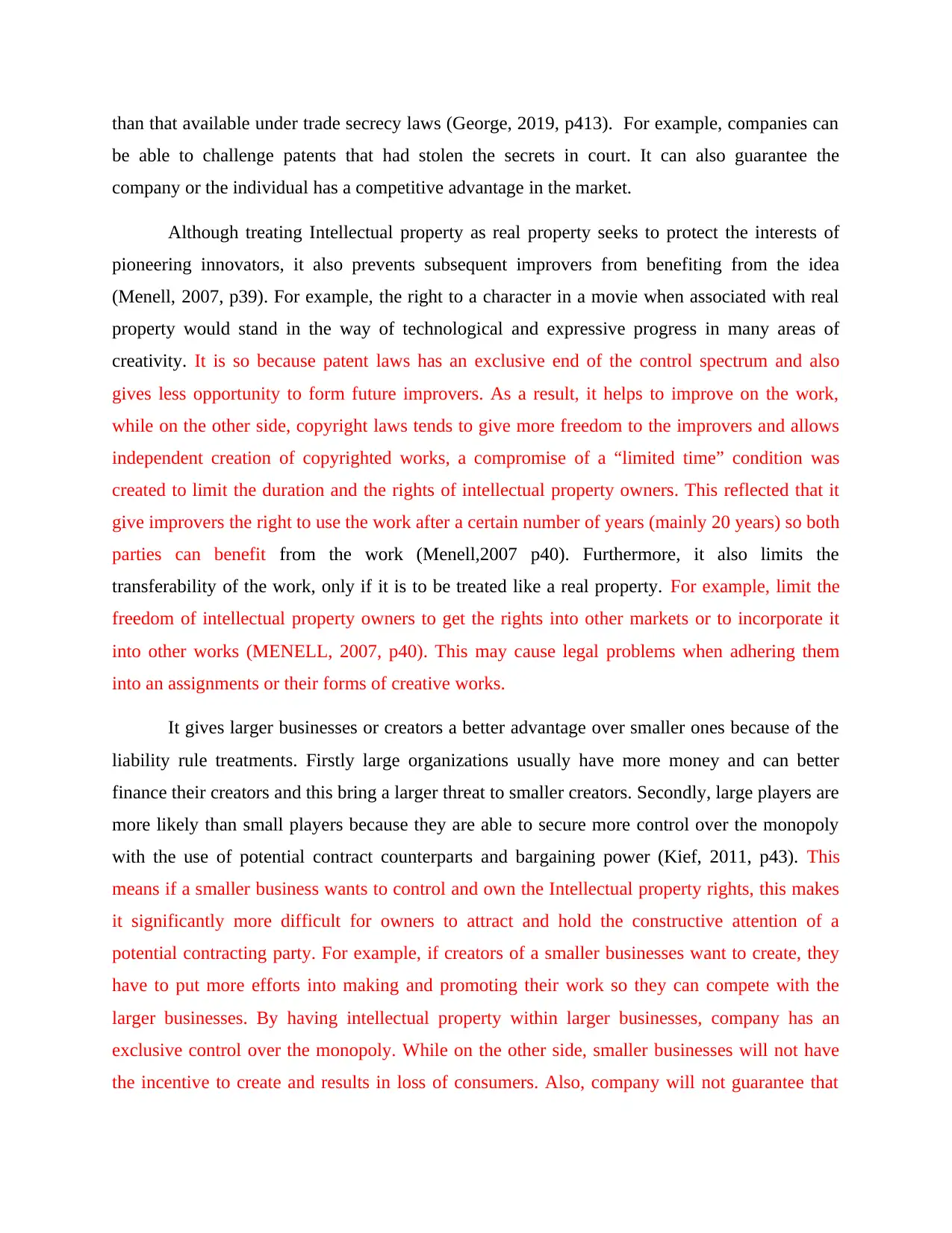
than that available under trade secrecy laws (George, 2019, p413). For example, companies can
be able to challenge patents that had stolen the secrets in court. It can also guarantee the
company or the individual has a competitive advantage in the market.
Although treating Intellectual property as real property seeks to protect the interests of
pioneering innovators, it also prevents subsequent improvers from benefiting from the idea
(Menell, 2007, p39). For example, the right to a character in a movie when associated with real
property would stand in the way of technological and expressive progress in many areas of
creativity. It is so because patent laws has an exclusive end of the control spectrum and also
gives less opportunity to form future improvers. As a result, it helps to improve on the work,
while on the other side, copyright laws tends to give more freedom to the improvers and allows
independent creation of copyrighted works, a compromise of a “limited time” condition was
created to limit the duration and the rights of intellectual property owners. This reflected that it
give improvers the right to use the work after a certain number of years (mainly 20 years) so both
parties can benefit from the work (Menell,2007 p40). Furthermore, it also limits the
transferability of the work, only if it is to be treated like a real property. For example, limit the
freedom of intellectual property owners to get the rights into other markets or to incorporate it
into other works (MENELL, 2007, p40). This may cause legal problems when adhering them
into an assignments or their forms of creative works.
It gives larger businesses or creators a better advantage over smaller ones because of the
liability rule treatments. Firstly large organizations usually have more money and can better
finance their creators and this bring a larger threat to smaller creators. Secondly, large players are
more likely than small players because they are able to secure more control over the monopoly
with the use of potential contract counterparts and bargaining power (Kief, 2011, p43). This
means if a smaller business wants to control and own the Intellectual property rights, this makes
it significantly more difficult for owners to attract and hold the constructive attention of a
potential contracting party. For example, if creators of a smaller businesses want to create, they
have to put more efforts into making and promoting their work so they can compete with the
larger businesses. By having intellectual property within larger businesses, company has an
exclusive control over the monopoly. While on the other side, smaller businesses will not have
the incentive to create and results in loss of consumers. Also, company will not guarantee that
be able to challenge patents that had stolen the secrets in court. It can also guarantee the
company or the individual has a competitive advantage in the market.
Although treating Intellectual property as real property seeks to protect the interests of
pioneering innovators, it also prevents subsequent improvers from benefiting from the idea
(Menell, 2007, p39). For example, the right to a character in a movie when associated with real
property would stand in the way of technological and expressive progress in many areas of
creativity. It is so because patent laws has an exclusive end of the control spectrum and also
gives less opportunity to form future improvers. As a result, it helps to improve on the work,
while on the other side, copyright laws tends to give more freedom to the improvers and allows
independent creation of copyrighted works, a compromise of a “limited time” condition was
created to limit the duration and the rights of intellectual property owners. This reflected that it
give improvers the right to use the work after a certain number of years (mainly 20 years) so both
parties can benefit from the work (Menell,2007 p40). Furthermore, it also limits the
transferability of the work, only if it is to be treated like a real property. For example, limit the
freedom of intellectual property owners to get the rights into other markets or to incorporate it
into other works (MENELL, 2007, p40). This may cause legal problems when adhering them
into an assignments or their forms of creative works.
It gives larger businesses or creators a better advantage over smaller ones because of the
liability rule treatments. Firstly large organizations usually have more money and can better
finance their creators and this bring a larger threat to smaller creators. Secondly, large players are
more likely than small players because they are able to secure more control over the monopoly
with the use of potential contract counterparts and bargaining power (Kief, 2011, p43). This
means if a smaller business wants to control and own the Intellectual property rights, this makes
it significantly more difficult for owners to attract and hold the constructive attention of a
potential contracting party. For example, if creators of a smaller businesses want to create, they
have to put more efforts into making and promoting their work so they can compete with the
larger businesses. By having intellectual property within larger businesses, company has an
exclusive control over the monopoly. While on the other side, smaller businesses will not have
the incentive to create and results in loss of consumers. Also, company will not guarantee that
Paraphrase This Document
Need a fresh take? Get an instant paraphrase of this document with our AI Paraphraser
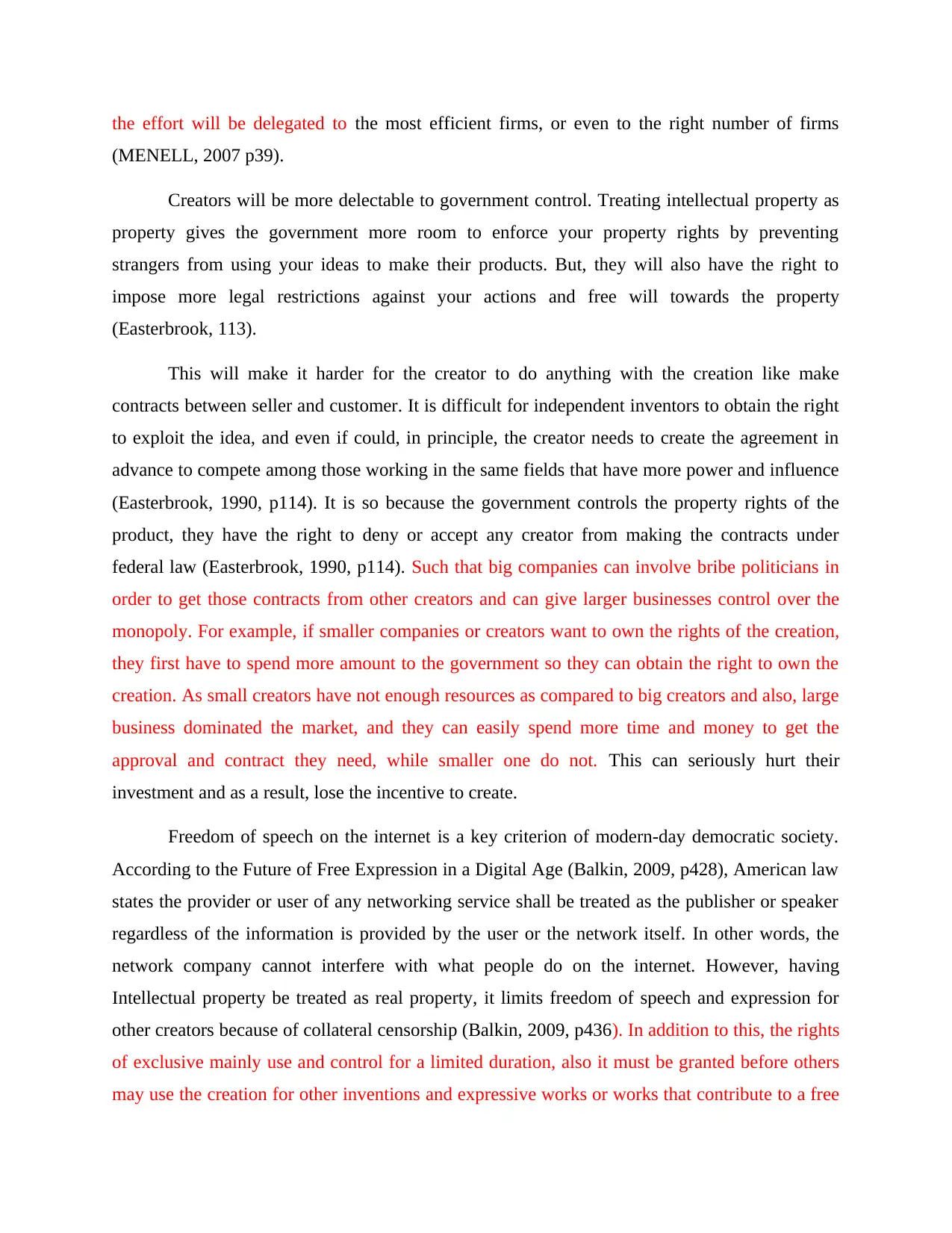
the effort will be delegated to the most efficient firms, or even to the right number of firms
(MENELL, 2007 p39).
Creators will be more delectable to government control. Treating intellectual property as
property gives the government more room to enforce your property rights by preventing
strangers from using your ideas to make their products. But, they will also have the right to
impose more legal restrictions against your actions and free will towards the property
(Easterbrook, 113).
This will make it harder for the creator to do anything with the creation like make
contracts between seller and customer. It is difficult for independent inventors to obtain the right
to exploit the idea, and even if could, in principle, the creator needs to create the agreement in
advance to compete among those working in the same fields that have more power and influence
(Easterbrook, 1990, p114). It is so because the government controls the property rights of the
product, they have the right to deny or accept any creator from making the contracts under
federal law (Easterbrook, 1990, p114). Such that big companies can involve bribe politicians in
order to get those contracts from other creators and can give larger businesses control over the
monopoly. For example, if smaller companies or creators want to own the rights of the creation,
they first have to spend more amount to the government so they can obtain the right to own the
creation. As small creators have not enough resources as compared to big creators and also, large
business dominated the market, and they can easily spend more time and money to get the
approval and contract they need, while smaller one do not. This can seriously hurt their
investment and as a result, lose the incentive to create.
Freedom of speech on the internet is a key criterion of modern-day democratic society.
According to the Future of Free Expression in a Digital Age (Balkin, 2009, p428), American law
states the provider or user of any networking service shall be treated as the publisher or speaker
regardless of the information is provided by the user or the network itself. In other words, the
network company cannot interfere with what people do on the internet. However, having
Intellectual property be treated as real property, it limits freedom of speech and expression for
other creators because of collateral censorship (Balkin, 2009, p436). In addition to this, the rights
of exclusive mainly use and control for a limited duration, also it must be granted before others
may use the creation for other inventions and expressive works or works that contribute to a free
(MENELL, 2007 p39).
Creators will be more delectable to government control. Treating intellectual property as
property gives the government more room to enforce your property rights by preventing
strangers from using your ideas to make their products. But, they will also have the right to
impose more legal restrictions against your actions and free will towards the property
(Easterbrook, 113).
This will make it harder for the creator to do anything with the creation like make
contracts between seller and customer. It is difficult for independent inventors to obtain the right
to exploit the idea, and even if could, in principle, the creator needs to create the agreement in
advance to compete among those working in the same fields that have more power and influence
(Easterbrook, 1990, p114). It is so because the government controls the property rights of the
product, they have the right to deny or accept any creator from making the contracts under
federal law (Easterbrook, 1990, p114). Such that big companies can involve bribe politicians in
order to get those contracts from other creators and can give larger businesses control over the
monopoly. For example, if smaller companies or creators want to own the rights of the creation,
they first have to spend more amount to the government so they can obtain the right to own the
creation. As small creators have not enough resources as compared to big creators and also, large
business dominated the market, and they can easily spend more time and money to get the
approval and contract they need, while smaller one do not. This can seriously hurt their
investment and as a result, lose the incentive to create.
Freedom of speech on the internet is a key criterion of modern-day democratic society.
According to the Future of Free Expression in a Digital Age (Balkin, 2009, p428), American law
states the provider or user of any networking service shall be treated as the publisher or speaker
regardless of the information is provided by the user or the network itself. In other words, the
network company cannot interfere with what people do on the internet. However, having
Intellectual property be treated as real property, it limits freedom of speech and expression for
other creators because of collateral censorship (Balkin, 2009, p436). In addition to this, the rights
of exclusive mainly use and control for a limited duration, also it must be granted before others
may use the creation for other inventions and expressive works or works that contribute to a free
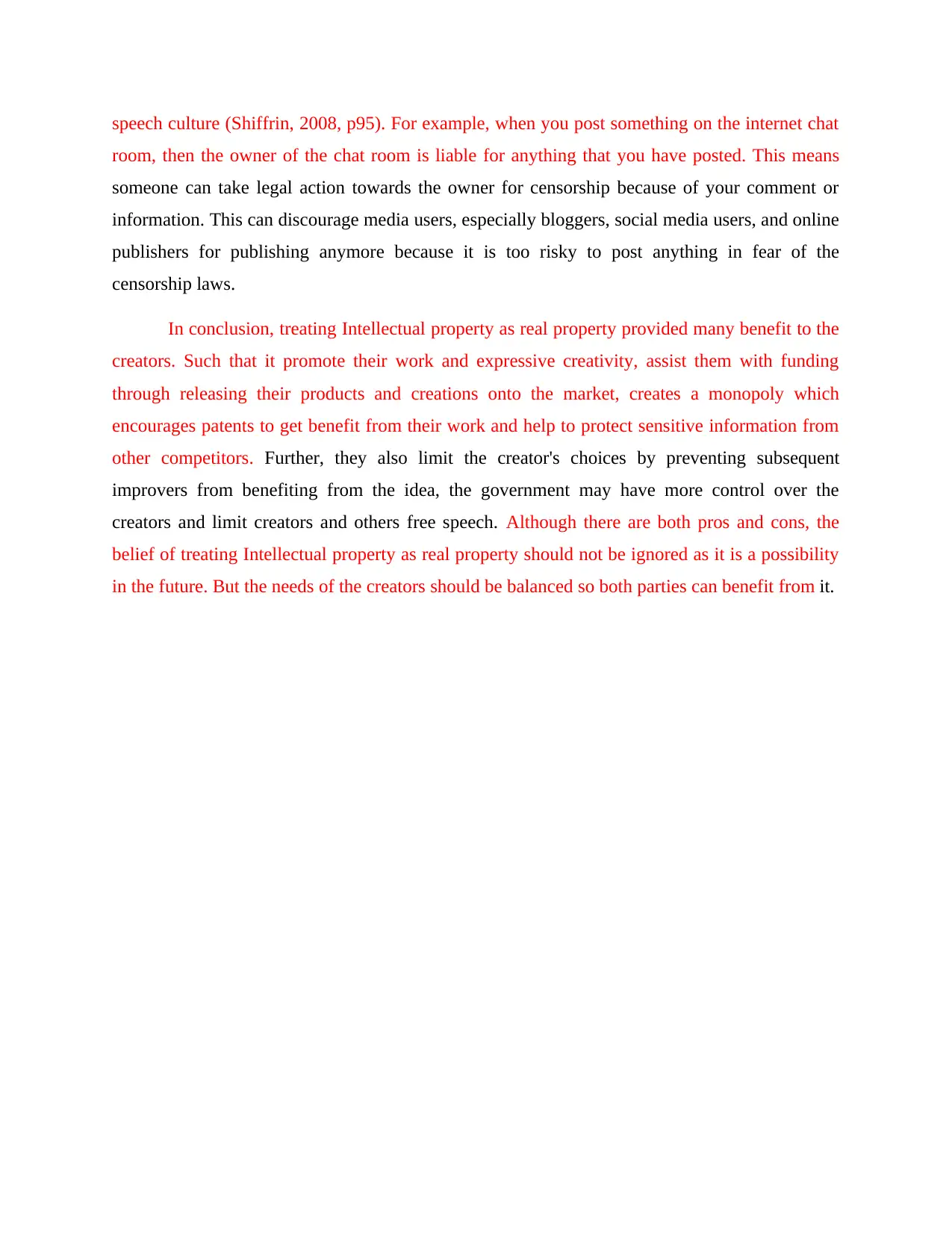
speech culture (Shiffrin, 2008, p95). For example, when you post something on the internet chat
room, then the owner of the chat room is liable for anything that you have posted. This means
someone can take legal action towards the owner for censorship because of your comment or
information. This can discourage media users, especially bloggers, social media users, and online
publishers for publishing anymore because it is too risky to post anything in fear of the
censorship laws.
In conclusion, treating Intellectual property as real property provided many benefit to the
creators. Such that it promote their work and expressive creativity, assist them with funding
through releasing their products and creations onto the market, creates a monopoly which
encourages patents to get benefit from their work and help to protect sensitive information from
other competitors. Further, they also limit the creator's choices by preventing subsequent
improvers from benefiting from the idea, the government may have more control over the
creators and limit creators and others free speech. Although there are both pros and cons, the
belief of treating Intellectual property as real property should not be ignored as it is a possibility
in the future. But the needs of the creators should be balanced so both parties can benefit from it.
room, then the owner of the chat room is liable for anything that you have posted. This means
someone can take legal action towards the owner for censorship because of your comment or
information. This can discourage media users, especially bloggers, social media users, and online
publishers for publishing anymore because it is too risky to post anything in fear of the
censorship laws.
In conclusion, treating Intellectual property as real property provided many benefit to the
creators. Such that it promote their work and expressive creativity, assist them with funding
through releasing their products and creations onto the market, creates a monopoly which
encourages patents to get benefit from their work and help to protect sensitive information from
other competitors. Further, they also limit the creator's choices by preventing subsequent
improvers from benefiting from the idea, the government may have more control over the
creators and limit creators and others free speech. Although there are both pros and cons, the
belief of treating Intellectual property as real property should not be ignored as it is a possibility
in the future. But the needs of the creators should be balanced so both parties can benefit from it.
1 out of 6
![[object Object]](/_next/static/media/star-bottom.7253800d.svg)